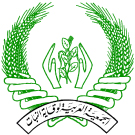Author's Guide for Manuscript Preparation
The author should submit the original manuscript plus three copies with the figures and tables to: Arab Society for Plant Protection, P.O. Box 113-6057, Beirut , Lebanon, e-mail: [email protected] Each manuscript is reviewed simultaneously by three specialists. Other reviewers are consulted if necessary. Submission of an article implies that it has not been published or submitted elsewhere. Whenever possible, sending a diskette form of the manuscript will facilitate production and reduce mistakes. For Arabic and or English manuscripts we prefer using the Microsoft Word. Manuscripts can only be accepted if at least one of the authors is a member of the Arab Society for Plant Protection.
Journal Language: Arab researches should send their articles in Arabic with an Arabic and English abstracts. Non-Arabic speaking scientists can write their articles in English with an English and Arabic abstracts (if possible). In case one of the authors is non-Arabic speaking, the authors has the choice to publish the article in either English or Arabic.
Types of Papers: The Journal accepts regular research papers (6-10 pages), short communications (2-3 pages) (please see manuscript writing) and New Pest and Natural Enemies Record (half page, maximum 500 words, including five reference, but without tables or figures).
Manuscript Writing: Manuscripts should be written in clear, concise language, type-written double spaced on a 21 x 28 cm paper and on one side only. The first page should start with the title in the center, which should be not be more than 100 characters and spaces, followed by the author(s) name(s) with the address, directly under the title. Key words, maximum six, would be useful for index retrieval systems. All manuscripts should contain the following sections: 1) Arabic abstract, which should be as brief as possible, including the significant contents and major findings of the work (not more than 200 words), 2) Introduction, 3) Material and Methods, 4) Results, 5) Discussion, in short communications results and Discussion could be combined in one section, 6) Acknowledgment (if necessary), 7) English abstract, 8) References. Footnotes are not permitted in the text.
Numbers to be used in the text, in the tables and in the figures are the "Arabic numbers" that is 1, 2, 3......etc.
The journal publishes also Short Communications which need not be divided into sections since they are short (two or three pages with one table and/or one figure): however, it should include an Arabic and English abstracts.
Tables: Tables should be planned to fit a maximum page of 18 x 26 cm. it should be typed on separate pages and numbered consecutively in the sequence of their appearance in the text. They should bear a descriptive, self-explanatory clear heading in both Arabic and English. Also sub-heading and terms should be written in both languages. Numbers to be used in the tables are the "Arabic numbers". Footnotes to tables should appear as a superscript letters starting with "a" in each table, and should be indicated at the bottom of the table.
Figures (Diagrams, graphs, photographs): Diagrams and graphs should be drawn using the Microsoft Word or Microsoft Excel. When authors present their data in a histogram form, the values should be printed on the top of each column. Captions should be typed in both English and Arabic. Only black and white photographs are accepted. If the author prefers colored photographs, the extra cost will be on his/her account. An estimate of the extra charge will be sent for each individual.
The size of the figures should be 9 cm wide (for a column) or 18 cm wide (for a complete page), and should not exceed 26 cm in height. including the captions. Numbers to be used on the figures are the "Arabic numbers". Figures must be numbered consecutively according to their citation in the text.
Names and Terms: Latin binomials should be written in italics or underlined to differentiate them from the rest of the text. Pesticides should be named by their common names.
References: Articles should be cited in the original language they were published in. References are numbered and arranged in an alphabetical order, with the author's last name first followed by his initials, the publication year, title, journal or publication place, the volume and pages. References are cited in the text by their numbers (Arabic).
Examples
-
Article in a Journal
Cockbain, A.J. and C.L. Costa. 1973. Comparative transmission of bean leaf roll and pea enation mosaic viruses by aphids. Annals of Applied Biology, 73:167-176.
-
Abstract
Hymaydan, H.S. 1983. Impact of seed-borne pathogens on intranational and international movement of seeds. Phytopathology, 73:784.
-
Books
Talhouk, A.M.S. 1969. Insects and mites injurious to crops in Middle Eastern Countries. Verlag Paul Parey, Hamburg and Berlin, West Germany. 239 pp.
-
Chapter in a book
Makkouk, K.M. and H. Laterrot. 1983. Epidemiology and control of tomato yellow leaf curl virus. Pages 315-321. In: Plant Virus Epidemiology. R.T. Plumb and K.M. Hresh (eds.). Blackwell Scientific Publications, Oxford. 377 pp.
-
Proceedings
Makkouk, K.M. and S.G. Kumari. 1997. Etiology and control of soybean dwarf luteovirus affecting lentils (Lens culinaris) in Syria. Pages 731-734. In: Proceedings of 10th Congress of the Mediterranean Phytopathological Union. June 1-5, 1997, Montpellier-Lec Corum, France.
-
Bulletins
Mustafa, F.H. 1974. List of plant diseases in Iraq. Bulletin No. 74. Ministry of Agriculture, Iraq. 27 pp.

